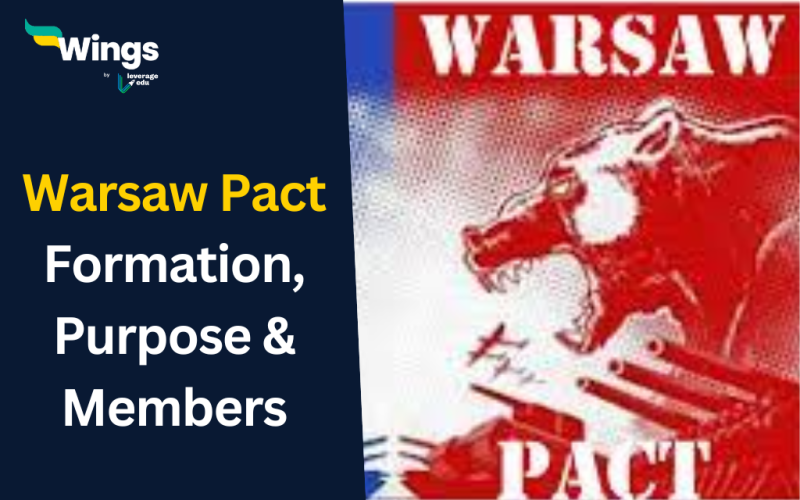Hey, guys! Mr. Owl 🦉 is here. I see that you want to know about ‘Warsaw Pact’ Hootfully, I’ll be of help to you! Since we owls are very wise. If you scroll further down this blog, you’ll see all the information you will need!
Table of Contents
The Cold War, a period of intense rivalry between the United States and the Soviet Union, witnessed the formation of several military alliances. One such alliance was the Warsaw Pact, a significant historical entity that often stood in opposition to NATO.
The Warsaw Pact is something that must be covered for UPSC preparation and upcoming government exams. Questions may revolve around the formation of the Warsaw Pact to its dissolution. To learn about all the necessary information regarding this crucial event, go through the blog below.
📄What is the Warsaw Pact?
- The Warsaw Pact, officially known as the Treaty of Friendship, Cooperation, and Mutual Assistance, was a military alliance formed on May 14, 1955.
- It united the Soviet Union and seven Eastern European countries, creating a counterbalance to the Western alliance of NATO.
- The founding members included Bulgaria, Czechoslovakia, East Germany, Hungary, Poland, Romania, and Albania.
Quick Facts About the Warsaw Pact
- The Warsaw Pact was the largest military alliance in history during the Cold War, rivalling its Western counterpart, NATO.
- In 1961, the Soviet Union erected the Berlin Wall, which became an iconic symbol of the Cold War division.
Must Read: What is Colonialism: Definition, History, and Significance
⏳Warsaw Pact Timeline (PDF Available)
To download the Warsaw Pact Timeline PDF, click here.
- 1955: Establishment of the Warsaw Pact in Warsaw, Poland, in response to the inclusion of West Germany in NATO.
- 1956: Warsaw Pact intervention in the Hungarian Revolution, quashing the uprising and causing significant casualties.
- 1968: Albania’s withdrawal from the Warsaw Pact.
- 1970s: Period of heightened tension as the Warsaw Pact and NATO engaged in military exercises.
- 1980s: Decline of the Warsaw Pact due to economic and political problems in the Soviet Union.
- 1989: The fall of the Berlin Wall and the collapse of communist governments in Eastern Europe.
- 1991: The dissolution of the Warsaw Pact in Prague, Czechoslovakia.

✍️Who Created the Warsaw Pact and Why?
- The Warsaw Pact was created by the Soviet Union as a response to the admission of West Germany into NATO in 1955.
- The Soviet Union aimed to establish a military alliance to counterbalance NATO’s presence and maintain its influence over Eastern Europe.
- This move was pivotal in asserting Soviet dominance and ensuring its sphere of control during the Cold War.
📋List of Warsaw Pact Countries
The member countries of the Warsaw Pact included:
- Albania (until 1968)
- Bulgaria
- Czechoslovakia
- East Germany
- Hungary
- Poland
- Romania
- Soviet Union
🇮🇳Did India Join the Warsaw Pact?
- No, India did not join the Warsaw Pact. India has adhered to a policy of non-alignment since gaining independence in 1947.
- This stance allowed India to maintain its independence, pursue its foreign policy goals, and engage with both superpower blocs without formally aligning with either.
- Another name for non-alignment is NAM. The Non-Aligned Movement (NAM) was a coalition of 120 countries that was not formally allied with or against any major power bloc. After the United Nations, it is the largest grouping of states worldwide.
🔄How Did Warsaw Counteract NATO?
The Warsaw Pact employed various strategies to counteract NATO:
- The Warsaw Pact maintained a formidable military force, comparable in size to NATO, to deter aggression and preserve Soviet control over Eastern Europe.
- Regular military exercises enhanced coordination and cooperation among Warsaw Pact forces, preparing them for potential conflict.
- The Soviet Union used its political influence to discourage NATO expansion and the deployment of new weapons systems, while also attempting to sow discord within the Western alliance.
These efforts contributed to the balance of power during the Cold War, preventing any major conflicts between the two superpower blocs.
🚮When Was the Warsaw Pact Dissolved?
- The Warsaw Pact was dissolved on July 1, 1991, marking the end of its existence.
- This dissolution followed the collapse of the Soviet Union and the momentous changes occurring in Eastern Europe.
“Kiddos, I’ve answered all your queries with the utmost precision that I was capable of. Now, I’ll be taking my leave, but if you think I might have missed something, do check out the FAQ section or drop a comment. I always respond!
Also Read: What is Socialism? Definition, History, and Significance
FAQs
The primary purpose of the Warsaw Pact was to deter aggression from NATO and to maintain Soviet control over Eastern Europe during the Cold War.
Yes, Albania withdrew from the Warsaw Pact in 1968, signalling discord within the alliance.
The Warsaw Pact helped maintain the balance of power by providing a counterbalance to NATO, reducing the risk of a full-scale conflict between the two superpower alliances.
RELATED BLOGS
In conclusion, the Warsaw Pact played a historical role in the Cold War by serving as a military alliance for the Soviet Union and its Eastern European allies. Hope you have gotten all the relevant information about ‘Warsaw Pact’!
If you want to know more about topics like this, then visit our general knowledge page! Alternatively, you can also read our blog on general knowledge for competitive exams!
 One app for all your study abroad needs
One app for all your study abroad needs













